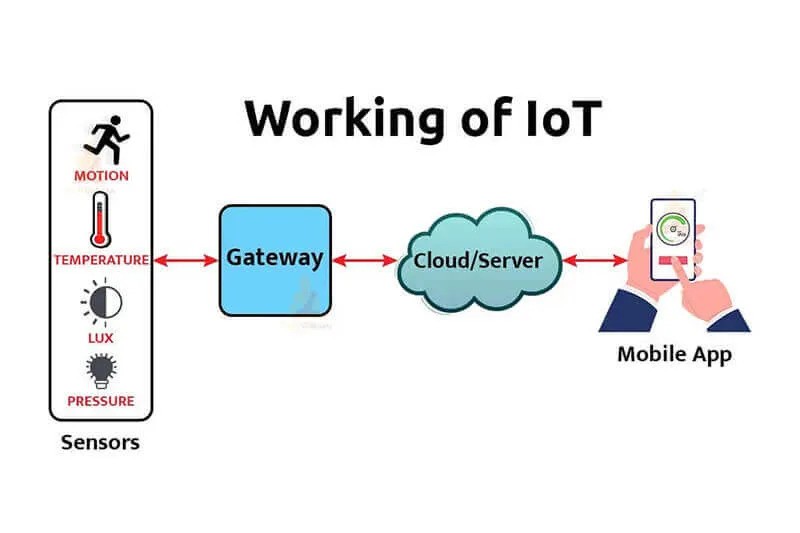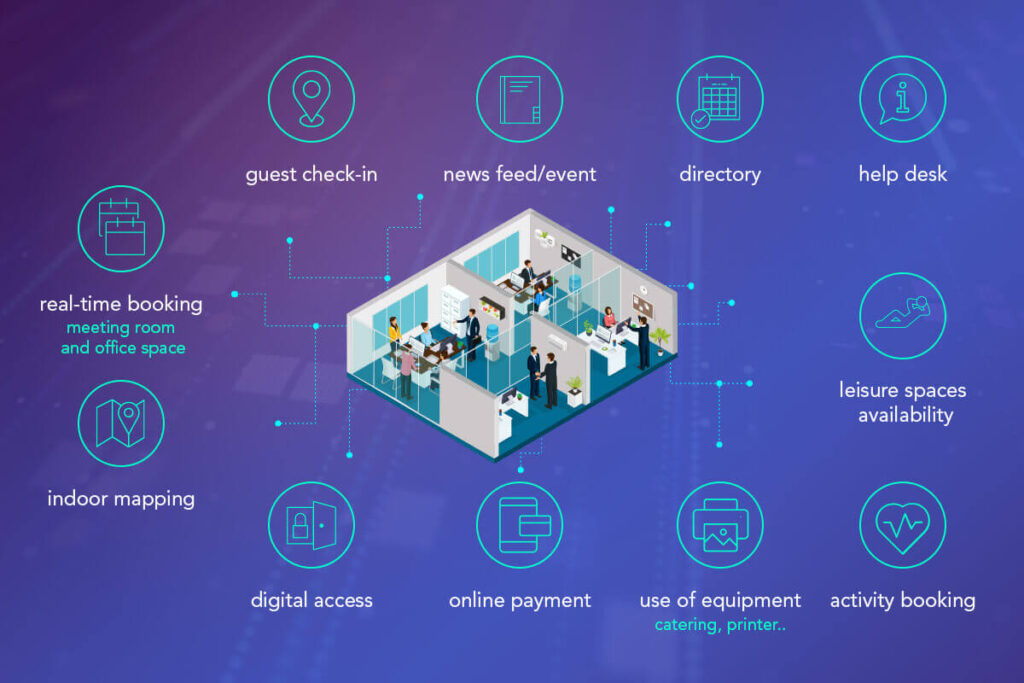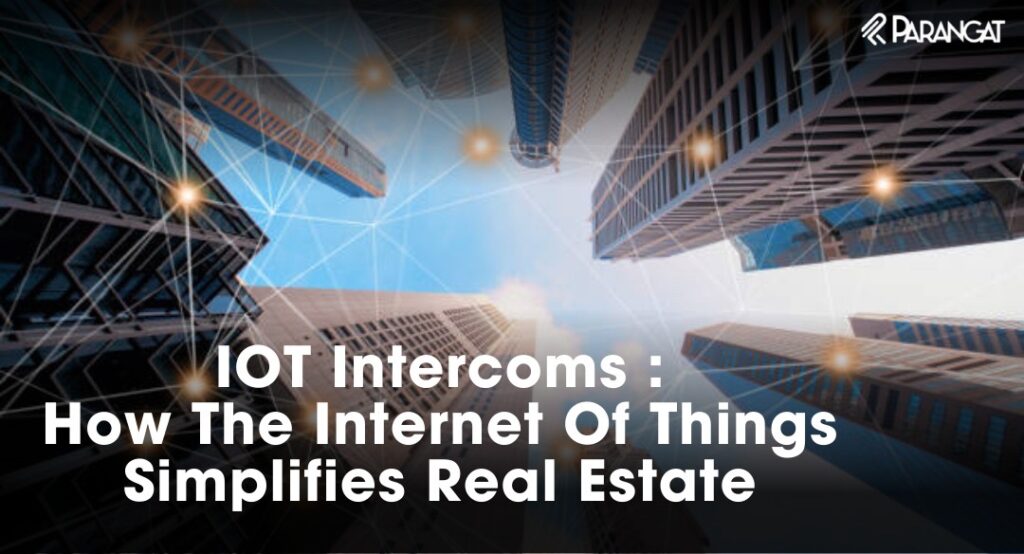Today, it’s a common occurrence that numerous smart devices communicate with each other, sharing information and enhancing the quality of daily tasks. An astonishing rate of more than 120 items are connecting to the web every passing second. Regardless of your work, opportunities are high that you’ve already experienced one of these devices in your day. Among this array of Generative AI Development lies the IoT intercom.
It may come as a surprise that an intercom system within a facilitator is a component of the Internet of Things network. Nonetheless, an IoT intercom fosters a safe and efficient way to manage access to properties. Stay tuned to learn about the functions of an IoT intercom and how it contributes to improving the overall living and working environment for both employees and residents.
What is the Internet of Things?
Devices that share data by using the Internet to communicate with each other are encompassed in the concept known as the Internet of Things. With the increasing accessibility of the Generative ai development services, these instruments depend on it to transmit the data they compile to other instruments. Communication among IoT devices is facilitated through the cloud.
When objects establish connections at an advanced level, they have the potential to eradicate inefficiencies and address challenges on a remarkable scale. For instance, consider UPS’s adoption of IoT technology. By integrating smart sensors into their vehicles, UPS gained insights to enhance trucking routes and pinpoint the trucks requiring maintenance.
What is an IoT Intercom?
IoT intercoms use the internet to enhance communication capabilities and add new features. They share some similarities with IP intercoms but use a broader range of the internet. While IP intercoms mainly enable wireless communication, IoT intercoms utilize sensors and processing power to leverage the full potential of the internet.

The IoT intercom allows users to connect from anywhere, enabling them to grant access remotely. It supports flawless audio communication, and some models also offer video communication. Additionally, certain IoT intercoms provide a mobile app for smartphone integration. By 2030, the global smart home market is projected to increase from $80.21 billion in 2022 to $338.28 billion, as indicated by recent findings.
How IoT works
The functionality of the Internet of Things is based on the interconnection of sensory-equipped devices, enabling them to share data and adjust to varying circumstances. A diverse array of IoT devices exist, each adhering to fundamental principles.
One crucial aspect is ensuring swift and accurate data transfer between devices. Devices must effectively respond to this data, which presents a significant challenge. The utilization of TCP/IP protocols, previously referenced, remains prevalent in current times.
IoT devices employ these protocols to transmit data to a designated processor, whether cloud-based or in close proximity. The processor is responsible for storing and analyzing the data while also coordinating the operation of other IoT hardware and software.
How Is IoT connected to real estate?
The intersection of real estate and the Internet of Things (IoT) represents a transformative AI Technology services, reshaping how properties are managed and experienced. Here are five key points highlighting the interconnectedness of real estate and IoT:
1. Smart Building Management Systems
IoT enables the creation of smart building management systems that centralize control over various building functions. From HVAC systems to lighting and security, real estate owners can remotely monitor and manage these systems for optimal efficiency and cost savings.
2. Occupant Personalization
IoT in real estate allows for the customization of spaces based on occupant preferences. Smart home devices can adapt to individual habits, providing a personalized and comfortable living environment. This personalization contributes to tenant satisfaction and loyalty.
3. Property Value Enhancement
The integration of IoT technologies adds a layer of modernity and functionality to real estate properties. Smart features not only enhance the overall living experience but also contribute to increased property values, making them more attractive to potential buyers or tenants.
4. Sustainable Building Practices
IoT sensors contribute to sustainable building practices by enabling efficient resource management. Smart energy systems, waste monitoring, and water conservation measures supported by IoT technology align with the growing demand for environmentally conscious real estate solutions.
5. Predictive Analytics for Real Estate
IoT-generated data provides real estate professionals with valuable insights into property usage patterns, maintenance needs, and market trends. By leveraging predictive analytics, property owners can make informed decisions, anticipate future demands, and stay ahead in a competitive real estate landscape.

In essence, the integration of IoT in real estate goes beyond mere technological advancements; it fundamentally transforms how properties are operated, adding value through efficiency, personalization, sustainability, and data-driven decision-making. This interconnected landscape propels real estate into a new era of smart, adaptive, and responsive spaces.
Benefits of an IoT Intercom
Generative AI development solutions simplify tenants’ lives by utilizing the Internet of Things technology. The key benefits of IoT intercoms are mentioned below:
1. Enhanced Property Security
IoT intercoms provide a robust security layer for real estate properties, allowing residents or property managers to remotely monitor and control access points. This contributes to a safer living environment, which is a significant factor for potential buyers or tenants.
2. Streamlined Visitor Management
The intercom system enables efficient visitor management by allowing residents to grant or deny access remotely. This is especially valuable in multi-unit buildings, ensuring that only authorized individuals can enter the premises and reducing the risk of unauthorized entry.
3. Convenient Property Access
With the convenience of mobile app integration, residents can easily manage and grant access to visitors from anywhere. This level of accessibility enhances the overall convenience of living in a property equipped with IoT intercoms, providing a modern and user-friendly experience.
4. Improved Tenant Experience
The integration of IoT intercoms with other smart home devices enhances the overall living experience for tenants. For example, seamless access control, coupled with smart thermostats or lighting systems, contributes to a more comfortable and technologically advanced lifestyle.
5. Increased Property Value
The inclusion of IoT intercom systems adds a modern and technologically advanced feature to a property, potentially increasing its market value. Buyers or renters often see such smart home technologies as attractive and desirable, making the property more competitive in the real estate market.
6. Remote Property Management
Property managers can efficiently oversee and manage multiple properties remotely through the IoT intercom system. This feature is particularly beneficial for real estate investors or managers with diverse property portfolios, enabling them to address access and security concerns without physical presence.
7. Visitor Analytics
The intercom system’s ability to log and record visitor data provides valuable insights for property management. This includes tracking visitor frequency, popular visiting times, and patterns, allowing for informed decision-making and improved security measures.
8. Customizable Access Permissions
The flexibility of setting customized access permissions based on specific criteria, such as time or day, caters to the diverse needs of real estate occupants. This adaptability is especially useful in properties with varied occupancy scenarios, such as residential complexes or mixed-use developments.
9. Emergency Response Integration
In the event of emergencies, residents can quickly and directly communicate with property management or emergency services through the intercom system. This contributes to a safer living environment and enhances the property’s overall emergency response capabilities.
10. Energy Efficiency and Sustainability
Some IoT intercom systems incorporate energy-efficient features, contributing to the property’s sustainability goals. For instance, motion sensors can activate the system only when needed, reducing unnecessary energy consumption and aligning with modern eco-friendly living expectations.
How Do Tenants Use IoT Intercoms?
Tenants leverage IoT intercoms for various purposes, enjoying a range of benefits that enhance their living experience. Here’s how tenants typically use IoT intercoms:
1. Secure Access Control
Tenants can control and monitor access to their premises remotely. Whether granting access to visitors, receiving deliveries, or managing entry for service providers, IoT intercoms offer a secure means of controlling who enters the property.
2. Remote Entry Authorization
With mobile app integration, tenants can grant entry to authorized guests even when they are away from home. This feature is particularly useful for accommodating friends, family, or service professionals without the need for physical presence.
3. Video Verification
IoT intercoms often include video surveillance features. Tenants can visually verify visitors before granting access, enhancing security by allowing them to confirm the identity of individuals at their doorsteps.
4. Communication with Delivery Personnel
In the era of online shopping, tenants use IoT intercoms to communicate with delivery personnel. They can provide instructions, grant access for package drop-offs, or remotely open entry points for a seamless delivery experience.
5. Emergency Communication
In case of emergencies, tenants can use the intercom system to communicate directly with property management or emergency services. This immediate access to assistance enhances tenant safety and contributes to a swift and effective emergency response.
6. Visitor Logs and Notifications
IoT intercoms maintain logs of visitors, allowing tenants to review who has accessed the property and when. Some systems also provide real-time notifications, keeping tenants informed about arrivals and ensuring heightened security awareness.
7. Integration with Smart Home Devices
Tenants often integrate IoT intercoms with other smart home devices, creating a cohesive smart living environment. This integration may include linking the intercom system with smart locks, lighting, or thermostats for a more connected and efficient home.
8. Customizable Access Permissions
Depending on the system’s capabilities, tenants can set customized access permissions. This could involve time-sensitive access or restrictions for certain individuals, providing flexibility in managing entry to the property.
9. Convenience in Multi-Unit Buildings
In multi-unit buildings, tenants appreciate the convenience of IoT intercoms for streamlined communication with neighbors and building management. It facilitates easy coordination and enhances the overall community living experience.
10. Energy-Efficient Living
Some IoT intercoms incorporate energy-saving features, such as activating the system only when necessary. Tenants benefit from energy-efficient living, contributing to reduced utility costs and aligning with environmentally conscious practices.
Tenants use IoT intercoms to enhance security, streamline access control, and enjoy the convenience of remote management, ultimately contributing to a more comfortable and connected living environment.
How Real Estate Professionals Can Use the Internet of Things
Real estate professionals can seamlessly integrate the Internet of Things (IoT) into their operations to unlock various advantages and streamline processes. By incorporating smart devices and sensors, they can enhance property management, offer innovative features, and stay ahead in a competitive market. Here’s a holistic view of how IoT can be applied in the real estate sector:
- Real-time monitoring of property equipment and systems through IoT allows for predictive maintenance, minimizing downtime, and reducing operational costs.
- Implementing IoT sensors aids in optimizing energy usage, promoting sustainable practices, and lowering utility costs for property owners and tenants.
- Highlighting IoT features, such as smart home automation, adds a modern and attractive dimension to property marketing efforts, catering to a tech-savvy audience.
- The data generated by IoT devices provides valuable insights, enabling real estate professionals to make informed decisions, predict market trends, and adjust strategies accordingly.
- Incorporating IoT-based security systems ensures robust protection for properties, with features like smart cameras and intercoms contributing to advanced safety measures.
- IoT facilitates remote monitoring and management, allowing professionals to efficiently oversee multiple properties, respond promptly to issues, and maintain optimal conditions.
- Leveraging the data from IoT devices helps streamline operations, from optimizing maintenance schedules to anticipating tenant needs and preferences.
- The integration of IoT devices into properties enhances the overall living experience, contributing to higher tenant satisfaction through features like smart home automation and personalized settings.
- IoT-enabled technologies, such as virtual reality (VR) or live-streamed property tours, provide an immersive experience for potential buyers or tenants, even when physical visits are challenging.
- Environmental monitoring through IoT ensures a healthy living or working environment, addressing factors like air quality and temperature to enhance the well-being of property occupants.
Conclusion
IoT intercoms have emerged as indispensable tools, simplifying real estate operations and elevating the overall living experience. These interconnected devices, seamlessly blending security, convenience, and efficiency, redefine the way properties are managed and accessed. With the power of the Internet of Things, real estate professionals can optimize security measures, offer smart living solutions, and make data-driven decisions for efficient property management. As the real estate landscape evolves, IoT intercoms stand out as transformative elements, providing a glimpse into the future of connected and intelligent properties. For innovative IoT solutions in real estate and beyond, consider exploring the expertise of Parangat , a Adaptive AI Development Company, paving the way for cutting-edge advancements in the realm of technology and property management.

With roll up sleeves, dive in and get the job done approach, it was in the year 2010 when Sahil started Parangat Technologies. Emphasizing a healthy work culture and technology-driven company, he has successfully created a workplace where people love to work and live. He is a software engineer and a passionate blockchain enthusiast.


 +44-7511-112566
+44-7511-112566 +353-1-8079571
+353-1-8079571 +1-415-799-9792
+1-415-799-9792

